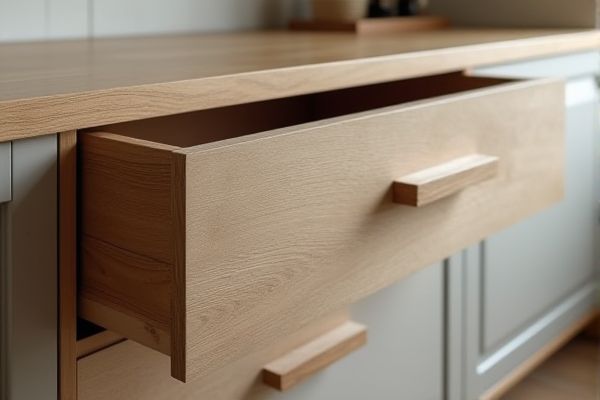
Rolling drawers offer mobility and easy access by gliding smoothly on tracks, making them ideal for flexible storage solutions, while fixed drawers provide stability and a sleek, stationary design suited for traditional cabinetry. Explore the rest of the article to understand which drawer type best fits your storage needs and personal preferences.
Table of Comparison
| Feature | Rolling Drawer | Fixed Drawer |
|---|---|---|
| Mobility | Highly mobile; can be moved easily | Stationary; fixed in one place |
| Installation | Minimal; plug and play | Requires mounting or built-in installation |
| Space Utilization | Flexible; can be repositioned to optimize space | Fixed; utilizes designated space only |
| Weight Capacity | Generally lower due to mobility features | Higher; supports heavier loads |
| Cost | Usually higher due to wheels and materials | Typically lower and simpler design |
| Best Use Case | Workshops, offices needing flexibility | Permanent setups like kitchen cabinets, desks |
Introduction to Rolling Drawer vs Fixed Drawer
A rolling drawer offers mobility and easy access, featuring wheels that allow you to move your storage space effortlessly across rooms or work areas. In contrast, a fixed drawer remains stationary, providing stability and permanence, often integrated into furniture or cabinetry for consistent use. Understanding the difference in flexibility and placement can help you choose the ideal drawer type for your storage needs.
Key Differences Between Rolling and Fixed Drawers
Rolling drawers offer mobility with built-in wheels, allowing easy repositioning and enhanced accessibility in dynamic spaces. Fixed drawers remain stationary, providing sturdy, stable storage ideal for consistent organization and heavy items. Your choice depends on whether flexibility or permanence best suits your storage needs.
Pros and Cons of Rolling Drawers
Rolling drawers offer superior mobility, allowing you to easily reposition your storage for convenience and flexible workspace organization. They can save space and improve accessibility, but may lack the stability of fixed drawers, making them less ideal for heavy items or permanent storage solutions. Your choice depends on whether you prioritize portability or a stable, anchored storage system.
Pros and Cons of Fixed Drawers
Fixed drawers offer enhanced durability and greater load-bearing capacity, making them ideal for heavy or frequently used items. Their stable design reduces the risk of drawer misalignment or accidental removal, providing consistent organization. However, fixed drawers lack the mobility of rolling drawers, limiting ease of access and making deep or compact spaces harder to utilize efficiently.
Space Efficiency: Rolling vs Fixed Drawers
Rolling drawers maximize space efficiency by allowing easy access to items stored deep within cabinets, reducing the need to remove other contents. Fixed drawers offer stable storage but often limit reachability and organization in tight spaces. You can optimize storage by choosing rolling drawers for versatile access in compact areas.
Mobility and Accessibility Comparison
Rolling drawers offer enhanced mobility by easily sliding in and out, making contents more accessible from different angles and positions within your workspace. Fixed drawers provide stability but limit accessibility to a single front-facing position, requiring you to reach deeper to access items. For tasks demanding frequent access and repositioning of tools or supplies, rolling drawers significantly improve convenience and efficiency.
Durability and Maintenance Factors
Rolling drawers typically feature metal roller or ball-bearing tracks that enhance durability by reducing friction and wear over time, making them resistant to frequent use and heavy loads. Fixed drawers lack moving components, which minimizes mechanical failures but can experience increased wear on wooden slides or runners, requiring regular maintenance such as lubrication or realignment. Maintenance for rolling drawers often involves periodic cleaning of tracks and lubricating bearings to ensure smooth operation, whereas fixed drawers demand less frequent but more manual care to prevent warping or sticking.
Cost Comparison: Rolling vs Fixed Drawers
Rolling drawers generally have higher upfront costs due to added components like wheels and tracks, which require more materials and assembly time compared to fixed drawers. Fixed drawers typically offer a more budget-friendly option as they have simpler construction without moving parts, reducing manufacturing expenses. Maintenance costs can be higher for rolling drawers because of potential wheel replacements and track lubrication, whereas fixed drawers typically incur lower upkeep costs over time.
Ideal Use Cases for Each Drawer Type
Rolling drawers excel in mobile workspaces or environments requiring frequent repositioning, such as workshops or offices with limited space where flexibility is key. Fixed drawers are best suited for static setups like kitchen cabinetry or built-in storage units, providing stable and durable storage for heavier items. You can optimize organization by selecting rolling drawers for versatility and fixed drawers for consistent, secure access.
How to Choose the Best Drawer for Your Needs
Choosing the best drawer for your needs depends on the intended use and ease of access required. Rolling drawers offer mobility and flexibility, making them ideal for dynamic workspaces or areas needing frequent repositioning, while fixed drawers provide stability and a streamlined design suited for permanent installations. Consider your space constraints, the weight of stored items, and how often you need to access the drawer to determine whether a rolling or fixed drawer best supports your organizational goals.
 homyna.com
homyna.com